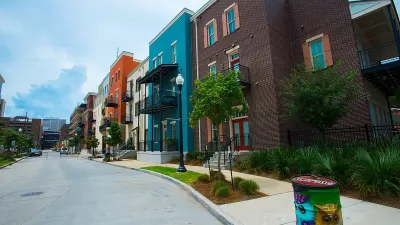It’s time to rewrite California’s building and planning codes for the 21st century, says architect Mark Hogan.

California's obstacles to addressing climate change and the housing shortage include its own code, a piece in BOOM argues.
Layers of code create what Hogan calls a "hairball"—a term borrowed from programming—in which, ultimately, "each bit of code can be used to stop another from doing its work." He writes:
Some of California’s own largest policy initiatives are at odds with each other … Reducing VMT requires density, but density is nearly impossible to achieve while constructing net-zero buildings.
To tease out some of the threads making up the hairball of code, Hogan tackles the history of planning, zoning, and building codes across California since the late 19th century. Though they generally arose independently in each city, early codes were defined by the times: they sought to counter the conditions of early American cities through ample space, separation from industry, and, of course, racist exclusion.
Though planning goals have changed, in many cases, codes have not kept up. Now, Hogan urges, "[in order to] create affordable cities, responsive to a changing climate and prudent with limited natural resources, we may need to rewrite the rules from scratch with a new set of goals in mind."
For one, he suggests semi-dense urban development—think low-rise apartments or in-law units:
Disallowing this kind of gentle medium density in the name of preserving neighborhood character does a disservice to those who arrived here or were born too late to afford a single-family home within commuting distance of their jobs. It also fails to recognize that making communities more walkable and sustainable will improve neighborhood character over time, not diminish it.
FULL STORY: Re-Coding Planning

Alabama: Trump Terminates Settlements for Black Communities Harmed By Raw Sewage
Trump deemed the landmark civil rights agreement “illegal DEI and environmental justice policy.”

Planetizen Federal Action Tracker
A weekly monitor of how Trump’s orders and actions are impacting planners and planning in America.

Why Should We Subsidize Public Transportation?
Many public transit agencies face financial stress due to rising costs, declining fare revenue, and declining subsidies. Transit advocates must provide a strong business case for increasing public transit funding.

Understanding Road Diets
An explainer from Momentum highlights the advantages of reducing vehicle lanes in favor of more bike, transit, and pedestrian infrastructure.

New California Law Regulates Warehouse Pollution
A new law tightens building and emissions regulations for large distribution warehouses to mitigate air pollution and traffic in surrounding communities.

Phoenix Announces Opening Date for Light Rail Extension
The South Central extension will connect South Phoenix to downtown and other major hubs starting on June 7.
Urban Design for Planners 1: Software Tools
This six-course series explores essential urban design concepts using open source software and equips planners with the tools they need to participate fully in the urban design process.
Planning for Universal Design
Learn the tools for implementing Universal Design in planning regulations.
Caltrans
Smith Gee Studio
Institute for Housing and Urban Development Studies (IHS)
City of Grandview
Harvard GSD Executive Education
Toledo-Lucas County Plan Commissions
Salt Lake City
NYU Wagner Graduate School of Public Service





























